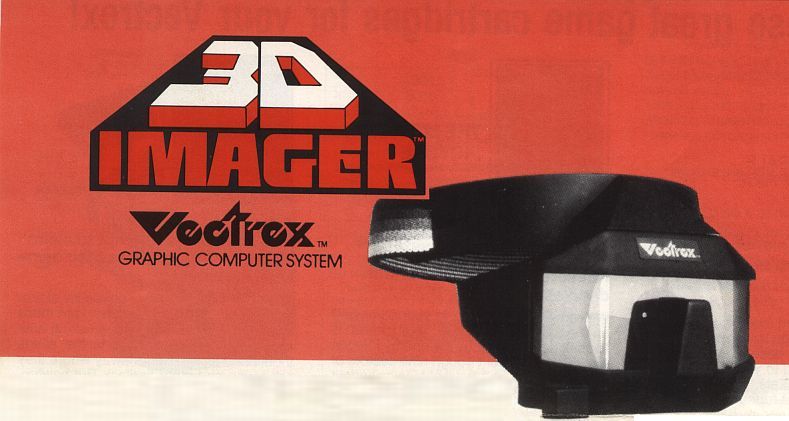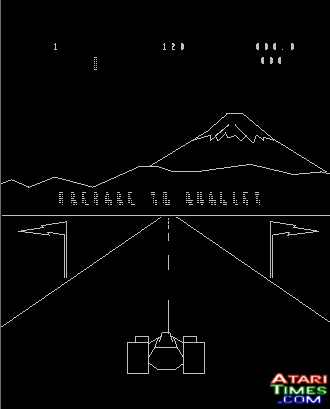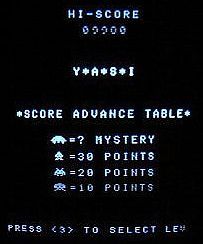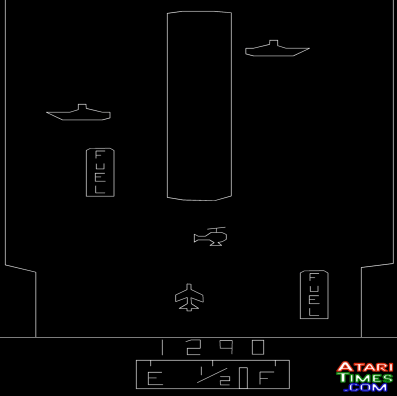 |
 |
Atari and the Vectrex |
|
The author's Vectrex, running the homebrew card game of Vector 21, along with... a hoola hoop in the background? (Don't ask.) |
First off, I'll get to the obvious: no, to the best of my knowledge, Atari and GCE, the creators of the Vectrex, never had any kind of business relationship with each other.
However, the POSSIBILITIES of such a relationship would have been pretty cool. But before we get into that...
HISTORY
For those who don't know, the Vectrex was a nifty little machine that made its debut into the crowded computer and gaming console world in 1982. Having its own monitor, it produced straight lined, or "wire frame" vector scan graphics that were popular in many arcade games, such as the Atari classics of Asteroids, Space Duel, Tempest, Major Havoc, and Star Wars, along with others produced by non-Atari companies such as Space War, Armor...Attack, Starhawk and Star Trek, among others. (All other consoles at the time that had to be attached to a TV [or a monitor for personal computers] utilized the square pixels, or raster scan graphics instead.) The Vectrex was also capable of utilizing 3-D graphics, rotating and scaling way better than most of the other home consoles at the time, even the more powerful ones (check out the jerky movements in the ColecoVision version of Zaxxon, for instance!).
As cool as this device was (even though it had no color, which would have made it very expensive), the Vectrex was, unfortunately, doomed from the start: other video game heavies of Atari and Intellivison (among others) had far more advertising bucks to spend, plenty of software was available for all the other consoles and computers at the time, personal computers were making their way into homes, and their prices were dropping as well. Milton Bradley had also bought out the Vectrex from GCE, which, as Milton Bradley was also being bought out by Hasbro at the time, Hasbro wasn't interested in video games, so the Vectrex television commercial (that CGE produced themselves) was withheld from any further TV airplay, also not helping with the Vectrex's future.
 |
|
Vecmania (left) has games based on the Atari vector coin-op classics of Star Wars, Asteroids, and Tempest, and Moon Lander is based on Lunar Lander |
Even with the convenience of not tying up a TV like all the other gaming consoles did (not counting handhelds) by having its own monitor, that was another one of the Vectrex's problems: the high price of producing the monitor, which, after repeatedly slashing the unit's price to try to remain competitive in the gaming world, ended up ultimately losing over $30 million when its production ended in 1984, as the great Video Game Crash killed it off for good then, due to the severe saturation of well over a dozen different gaming consoles and computers for consumers to pick from, along with the (aforementioned) tons of games that were available for them all as well (a lot of which were pretty bad, as companies had sprung up left and right over the years to try to make a buck, mostly off the Atari 2600).
And of course, you guys are familiar with the products Atari had out back then of the 2600, 5200, and later 7800, right? Ok then! ;)
AND THESE COMPANIES HAVE TO DO WITH...*WHAT*, NOW?
Backing up to what I said earlier, there were several arcade games that utilized vector graphics that were not producible for the home market, since home consoles back then had far less power than their arcade cousins. However, that's just in the look of the game, as Asteroids proved to be fairly close adaptation on the 2600, and closer versions were made, play-wise, for the 7800 and the Atari line of personal computers as well. Gravitar would also work pretty nicely for the 2600 too, I do believe the Sega ported Tac/Scan received decent reviews as well (even though the latter was stripped down to one stage from the arcade original), and I can vouch for their port of Star Trek on the same system working out pretty decently, since I've played that one. Parker Brothers also, in a bizarre twist of fate, brought home the Atari coin-op Star Wars to the 2600 when they acquired the Star Wars license. (Versions for Star Trek and Star Wars also made it to the Atari 5200 and ColecoVision as well, among various computer systems too.)
 |
|
Part of Moon Lander attract mode |
Now, that's the factual Atari side of this story, though.
Just what could have been expected if Atari produced games for the Vectrex?
WHAT WE HAVE THUS FAR
What I mean by "we" is the Vectrex community, with homebrews that were brought to life (so to say) by the influence of various Atari vector coin-op originals. (Of course, none of the games I'm going over are officially licensed Atari games, as gameplay has been altered a bit from their coin-op inspirations.)
Take Moon Lander, for instance, which was inspired by Atari's first ever vector coin-op Lunar Lander, as each planet you land on is different from the previous, having different gravity pulls, wind, and sometimes satellites to contend with as well. There is no "zooming" effect when your spacecraft nears the planet, unlike with the Atari original, but with different landscapes and the aforementioned pressures to have to deal with, along with a voice-digitized intro and cinematics of when you ship blasts off for the next moon, this 32K game (pretty large for a Vectrex homebrew) really surpassed the original.
And speaking of big games, the largest of them all (as of the time of this writing) is Gravitrex Plus by Vectrex homebrewing great John Dondzila, inspired by Atari's Gravitar. There were a few new wrinkles added, though, like rescuing people (like in Time Pilot, I suppose) on the planetscapes, which rescuing them and either beaming up or destroying every single fuel tank is now mandatory in order to destroy planets (unlike with Gravitar, where you only have to destroy all planetary bunkers in order to dispose of planets). Several landscapes will also seem familiar, but then have different designs as the player encounters more and more of them. And you know how you could either skip the reactor, or destroy it to automatically advance to the next solar system on Gravitar? Well, here, again, destroying a reactor is mandatory to go to the next solar system, plus the game ends after the third level, unlike with Gravitar, which has several more levels with invisible landscapes and the like, among other changes (like being able to earn a boatload of extra ships when rescuing all humans on a level, destroying the reactor, etc., rather that with just every 10,000 points on Gravitar).
There were also two gameplay versions created for the cartridge as well, as the Arcade variation is the exact same as the Regular mode, although the player's ship is more sensitive to the turning controls. The cartridge also weighs in at a whopping 64K (and remember when games came in kilo, rather than megabytes, by the way?).
 |
 |
|
Arcade Asteroids (above) and the Rockaroids Remix (below) |
Dondzila's Vecmania cartridge also has several Atari vector-inspired games in it as well, one of which is based on one of the vector arcade favorites of all, which is Star Wars. It plays a little differently though, as the camera view doesn't pan around to the next T.I.E. Fighter-like ship after you destroy it like the original does, as you have to wait until the next ones appear. Also, instead of a set pattern of a landscape (Death Starscape?) to blow the tops off laser towers in the second stage, they also appear randomly, although the final stage of navigating the trench (known as "Dark Planet" in this homebrew) is pretty much the same as the original's, although without catwalks to duck in the later levels.
Vecmania also contains a second version of Rockaroids, an Asteroids clone (obviously). This time however, the asteroids rotate around, like in the Atari arcade sequel of Asteroids Deluxe, and you are invincible for the first several seconds with every new onscreen life (thank goodness, it helps, the asteroids can move pretty fast!). And rounding out the Atari vector clones on the cartridge is a demo of a Tempest clone called Abyss, but Dondzila didn't fully plan out the game before diving into it, so he never finished it. All you have is one level that never ends (until you shut it off), as there's no way to die, no sounds, and hardly any of the enemies are present either, just Flippers, Spikes and Spikers.
Yes, I know, I see tons of light bulbs going off over your heads, going "Tempest! OMG!" As it says on the Vectrex database, "A vector game that so many had been waiting for - a Vectrex version of Tempest.", yes, the closest the Vectrex got to Tempest back in the day was with Bedlam, which was kind of a "Tempest in reverse," where you're in the middle, and objects come towards you. As far as modern homebrews go, though, a complete Tempest version was completed, known as Tsunami, by Christopher Tumber.
Unfortunately, the cartridge -- which also included a vector version of the arcade game Qix, known as Vix -- sold out, and Tumber "disappeared from the internet" (as I've read on forums) for several years, so it is unknown if he will ever produce any more cartridges. The game also does not currently run correctly on emulators, as the graphics are distorted, although all 16 levels of Tempest are present, although the feel of the game wasn't quite captured on the clone though.
 |
 |
|
Arcade Tempest (above) and the unfinished Abyss demo (below), on the John Dondzila homebrew Vecmania cartridge |
And as I mentioned Asteroids earlier, just like with Bedlam/Tempest back in the day, the closest we got to an
Asteroids game was with Mine Storm, which was built into the Vectrex. But then flashing forward to over a decade after the Vectrex "died," first limited version of Rockaroids, which the unlimited version of that game (for those who missed it when he first released it) made it onto his compilation cartridge of All Good Things. (However, for those that have seen the curious screenshot of an
Asteroids clone on the Video Game Museum website under its Gamepics section called the
BCor-FTS Demo [which stands for "Big Chunks Of Rock Floating Through Space," heh], made by Clay Cowgill [who also made
Moon Lander], this was never made out to be, nor released, as a full Asteroids-type game, it was just a demo for the ship's physics.) The game had some minor changes, such as the trajectory of the "rockaroids" moving in straight lines at times, rather than angles, the large saucers can still appear well after 10,000 points are scored, plus they do not destroy rockaroids when they collide with them. The player's ship is also indestructible with every life and new wave, plus most of the scoring was cut in half (only 10, 20 and 50 points for the large, medium and small rockaroids respectively vs. 20, 50 and 100 points for the same asteroids on the original game). And with the Rockaroids Remix ROM (not released on cartridge unless a player requested it from Dondzila), the rocks flew at an astonishingly fast rate.
WOW, THE COLOR--UH, THE *POSSIBILITIES*, MAN
Ok, finally we're onto the reason why this feature is here: the possibilities of Atari-ported vector games if they were brought to the Vectrex!
One semi-popular hit (I don't know if the term of "cult" would fit here) -- and I feel, somewhat ignored -- of Atari's vector game of Black Widow might have worked out on the Vectrex. As I put up a warning to this feature at the very beginning, I hardly know anything about programming at all, so I'm not sure if this game could have been very doable; after all, the Vectrex suffered flickering with some of their games (just like the 2600!), along with slowdown (again, 2600...) with too many vector lines being drawn at once. So this might not have worked out too well, unless the port was scaled down a bit; after all, Widow was considered by many to be a "vector version of Robotron: 2084," which a Vectrex homebrew of Robotron was supposed to have been completed in 2004, but has yet to materialize...
(And likewise, Dondzila ironically did a stripped down version of Centipede as a hidden bonus game in one of his cartridges. The game only has mushrooms, your blaster, the spider, and the vectrepede, no fleas or scorpions included. Even though playable and can be fun at times, there's too much flicker and slowdown with too many mushrooms and the vectrepede onscreen. So Black Widow, even though a welcome addition to the Vectrex library if it were created, might not have worked out, like how Vectrepede feels a bit "unfinished" [to me, anyway] as well.)
Another one I'm not too sure about is Battlezone, which probably ranks right up there with Tempest as to what vector games Atari fans would want to see created for the Vectrex. Again, not knowing about programming, it seemed to me that, being able to handle 3-D and scaling, this would be fairly likely, but someone on the Vectrex forums (that actually knows about programming, or at least I assume) said it would take some pretty nifty programming tricks to be able to pull off a feat such as a Battlezone game. And since you could run both games off the same hardware with only a few modifications of the wiring harness (not counting the controls, though, according to it's entry at the Killer List of Video Games), I assume that leaves fellow Atari coin-ops Red Baron (which runs off the Battlezone hardware) and The Empire Strikes Back off the future homebrew list as well, unless someone's up to the challenge.
 |
|
The Vectrex 3D Imager add-on |
(Note: there was also an add-on known as the 3D Imager for the Vectrex as well, which I've also read on the Vectrex forums that even veteran Vectrex homebrewers REALLY have to know what they are doing in order to make games for the 3D Imager [or its later modern reproductions]. Right now there's only one homebrewed game that was made especially for the Imager (Lord of the Robots), and two more are slated for release in 2007. So using this for any homebrews seems to be a pretty slim chance, at best, as well.)
Probably a better chance of seeing the light of day on the Vectrex would be a Major Havoc clone, a unique game that was released during the video game crash, not getting a lot of attention. Running through a space station (after engaging in outer space dogfights) to destroy it by mucking up its reactor would be unique to the Vectrex as well, and being a personal favorite of mine, you know I'd be one of the first people to send whatever homebrewer an e-mail to get a shot at a place for its reserve list.
And we can't forget Space Duel! Ahhhh, another game (among several already available for the Vectrex) with simultaneous two player onscreen action would be very welcome (other Vectrex games of this nature include Armor...Attack, Space Wars, and the homebrews of a Discs of Tron demo on Vecmania, and Nebula Commander, among others). And with several Asteroids-type games available for the Vectrex already, what's one more, especially since it added several features that were unique to that genre? And I don't think Asteroids Deluxe would be too much trouble either -- just add the wedges and diamonds -- along with a vector version of Blasteroids (or it could go for a raster look, which I'll get to in the next section).
 |
|
Arcade version of Space Duel. |
Another kind of cult arcade hit that I don't think ever made it to any kind of compilation (even today) is Quantum. This unusual game required you to use a trackball to capture various objects that floated around onscreen. It probably would have been possible to port it to the 2600. The new homebrew of Star Sling has an element or two that's similar to Quantum, but it doesn't really count as a Quantum clone, since it's creator, Alex Nicholson, has stated that he had never heard of Quantum before he made his game. The game involves roping several objects together, which your string dissipates like with Quantum. However, you have to match/rope two similar objects at the same time so they will disappear; if you catch an object that differs then they'll multiply. So this is why Star Sling can't exactly be counted as a Quantum clone (which the same goes for VPong, since, running vertical and being for only one player, doesn't exactly count as a Pong clone either).
YOU CAN HAVE IT BOTH WAYS...
 |
|
Vectrex version of Pole Position. |
Of course, ports, or clones, were created for both sides, whether they were vector to begin with, but ended up raster, or vice versa: as far as the Vectrex went, the non-Atari arcade hits of Scramble and Berzerk weren't vector originally, but they were ported anyway to the system, as well as Pole Position (about the only thing the Vectrex had in common with any of Atari's systems [along with the similarities of both systems having a space war-type game], since Atari distributed the arcade original, made by Namco).
Vector homebrews of raster Atari clones were also released, like the aforementioned Vectrepede. Versions of Missile Command (known as Patriots) made it onto several Dondzila cartridges, as well as Breakout, a hidden bonus game in two of Dondzila's releases, along with a Tetris clone (Vectris, on his All Good Things compilation). Of course, there were the usual changes, as Vectris is simplified to only having one long level that just gets faster and faster until the pieces stack up to the top of the screen (as opposed to having levels that end and change on Tetris). Versions of Patriots also differ per release, as Patriots III on Gravitrex Plus, for instance, finally features all three bases that can fire (the first two versions of the game only had two firing bases), along with having unlimited ammo, although at times the bases have to reload, so there is no bonuses for remaining missiles at the end of a wave. The game's difficulty level is also fairly high as well.
Also, several versions of the game Kaboom!, which appeared on several Atari consoles and home computers (made by Activision), also have made it onto the homebrew scene, with two versions done by Dondzila (actually they play the same, one of them is just made specifically for the original Vectrex analog controller), called Spike's Water Balloons (which also allowed you to kick some back up to your enemy, Spud, a la the coin-op game of
Kickman), and on Vaboom!/Vectrace (Vaboom!, which allows a player to earn a bucket back by grabbing an onscreen heart, although catching the occasional 'X' that floats down will also rob a player of one of his paddles. Also, occasionally a bomb will fly up towards the bomber; smack him 10 times and you'll go to a bonus round where the bombs are worth not only three times their point value, but the player also won't lose a paddle if they miss a bomb). Dondzila also created
a racing demo that was akin to several of Atari's early top-viewed racing coin-ops of
Indy 4, Indy 800, and the 2600 game Indy 500. And a screenshot of the (as of yet) unfinished game of
Spudster's Revenge can be viewed on the Vectrex database, a version of the controversial 2600 game
Custer's Revenge. Oh my! However, there was also the (possibly PG rated at worst) Yars' Revenge clone of Koko's Retribution, released as a ROM file only to play on Vectrex emulators or flashcarts, and not on cartridge. Several changes were made, such as there being only one type of shield, the Quotile could not be killed in its "swirl" form, you could still get destroyed while being in the neutral zone, etc. However, the game also had a brief cutscene not in the original whenever the enemy is destroyed, along with other minor changes.
Oh, and I mentioned the Star Wars coin-op clone earlier, right? Well, there's actually another hidden Star Wars game on the Thrust cartridge, being a clone of the 2600 Parker Brothers game The Empire Strikes Back! Of course, it's a little different than the original, as your ship thrusts differently, there's no areas to repair your speeder, and the AT-AT-type machines only seem to be vulnerable in the head, no destroying them from behind or via bomb hatch or anything. The smart bombs act differently too (plus they can't be destroyed), and after you shoot several of the walkers, they start JUMPING, of all things! Funny stuff...but having the walkers start shooting several fast smart bombs at you at a time, not so much!
 |
|
Look familiar? |
The Vectrex is also capable of bitmapped graphics, which the excellent homebrew of Y. A. S. I. proves (which looks almost identical to the original Space Invaders coin-op). So that opens up even more possibilities, although there haven't been many of those kinds of games produced in that fashion (Debris, Color Clash), as most Vectrex owners prefer what made the Vectrex what it is: a vector graphics machine.
Also, on the VecCaves/Spike's Spree cartridge, Spike's Spree is a clone of the Atari 2600 game Fast Food. As the Vectrex didn't have color, rather than dealing with purple pickles, there was good and bad food that Spike (the "unofficial Vectrex mascot", who replaced the mouth from Fast Food) could eat, and the good food (Spike's girlfriend Molly, her bow) he had to eat in a certain order in order to advance through the game.
And likewise, as I mentioned earlier, non-vector versions of Gravitar and Asteroids have appeared on various Atari consoles (actually Gravitar was a 2600 only game, but Asteroids went pretty much everywhere!). Ironically enough, one of THE biggest hits of them all, Tempest, never made it past the prototype stage for the 2600, 5200, and 7800 consoles. A raster version of Space Duel made it to one of the modern Atari Flashback consoles, along with Major Havoc being ported to a home compilation on the home computer circuit a few years ago (actually it was planned for the Jaguar as well, but that never happened), and vector versions of Tempest, Asteroids, Gravitar, and Battlezone have appeared on various PC compilations as well.
And it would be pretty near impossible to cover all of the vector and non-vector Atari versions for various consoles and updates, like one-time Atari nemesis Activision (Atari sued them when they first hit the video game scene in the early days) ironically making PC updates to Asteroids and Battlezone, to other modern compilations on the Game Boy Advance (Lunar Lander on the Millipede Super Breakout Lunar Lander cartridge) to tons of other consoles and computers, which will continue until the end of time, I suppose.
And, like I said, it goes both ways: due to tons of us being fascinated with anything vector starting with the arcade heyday and from then on, there have been many 2600 "vector" hacks, like Defender and Asteroids (of course), altering the games' graphics to resemble wire-framed vector lines.
It's mind-boggling the influence that Atari and vector graphics have had over the years, to put it mildly.
And, since I can't figure out where else to put it in this article, the Logo programming language was released for the Atari personal computer line back in the 1980s, plus it was also made available for the Vectrex recently as well.
BACK TO THE FUTURE (OR PAST)...
 |
|
River Raid on the Vectrex? (Editor's rendition.) |
In conclusion, who knows what the future will bring to the Vectrex homebrew scene, and various Atari vector adaptions to all kinds of platforms, including hacks. Some Vectrex homebrewers prefer not to announce a project until it's nearly ready, so anything is possible, especially with how huge a library the 2600 alone has. After all, with it being able to handle scaling so well, it wouldn't surprise me one day to hear of a River Raid-type game coming out as a Vectrex homebrew (which reminds me, what about a clone of the Spy Hunter coin-op?).
As long as we have homebrewers that think "_____ Atari game is missing from the Vectrex's library," then Atari will never die.
Even for those that are reading this that don't own a Vectrex, you have to admit that is quite a nice thought, coming from two consoles that don't have much in common with each other, especially since they both "died" a couple of decades ago.
Thanks to Jeroen at www.vectrex.nl and Alex Nicholson from Vectorzoa.com for their info about some of the gameplay for Star Sling.
Edit: Even though this article instantly went out of date the moment it went online -- I've since gotten more homebrews, dating my photo of all the homebrews I had at the time, it's since been announced that one of the games for the 3D Imager might not be released in 2007 after all, etc. -- I'm just going to leave it pretty much "frozen" in time for when it was written. However, I couldn't believe that I forgot to include a link to a video I made of the homebrews, which you can see at http://www.youtube.com/watch?v=wq7T5P3bjnI . It's only a slideshow for now, but I'll eventually redo it using video instead of photos! So you'll be able to see even MORE of the Atari influence now!
SOURCES
| Name: | |
| Subject: | |
| Comment: | |
| Check: | What is the greatest video game company of all time? (Hint: Atari.) |